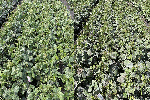Key points
- Maintaining good wheel tracks combines well-planned design and orientation, careful usage of wheel tracks during operations and a program of wheel-track renovation.
- There are now many commercial wheel-track renovators on the market, but growers will need to research the best option for their soil type and situation.
Anywhere that gets a lot of traffic needs maintenance, as a quick trip down our rural roads will prove. The wheel tracks in controlled-traffic farming (CTF) paddocks are no different.
Restricting heavy machinery to permanent wheel tracks has many benefits for the paddock overall, but with repeated passes the wheel tracks sink, increasing erosion risk and reducing the efficiency and effectiveness of paddock operations.
Maintaining good wheel tracks combines:
- well-planned design and orientation;
- careful usage of wheel tracks during operations; and
- a program of wheel-track renovation.
Well-designed layouts are less vulnerable to wind and water erosion and require less maintenance.
The same wheel track as above after deep ruts were filled in by a track renovator Photo: Bindi Isbister, WA DPIRD
Maintain versus renovate
Machinery usage patterns are important. While one of the benefits of controlled traffic is improved trafficability in the wet, it is worth avoiding very wet conditions as these will increase the potential for damage to the wheel tracks.
Another strategy is to alternate the wheel tracks that are used for spraying so that the same tracks are not used all of the time. Sprayer tracks are particularly vulnerable, as they are used more frequently and often under moist conditions and with narrower tyres compared to other machinery.
Once tracks become deep enough to hold water they are at increased risk of damage, particularly on heavier soils. Ruts of 20 centimetres deep are not uncommon, and depending on the soil type they can be much deeper.
Maintaining good wheel tracks combines well-planned design and orientation to reduce erosion risk, careful usage of tracks during operations and a program of track renovation.
Wheel-track renovation involves moving soil back into the wheel ruts and packing it down. The level of maintenance required will depend on the soil type, water movement and wind erosion.
There are now many commercial wheel-track renovators on the Australian market. Most are built in the eastern states and are best-suited to heavier soil types.
It is worth spending some time to research the best option for your soil type and system, and to talk to other growers about how they use their machines.
Getting the job done
Renovators have discs that cut and drag the soil back into the wheel track. It is important to pack down the soil as part of the renovation process because otherwise the tracks will rapidly sink after one pass with farm machinery.
Renovators tend to work best in moist, but not wet, soil. Aim to renovate paddocks when there is adequate ground cover to reduce erosion risk. Some stubble helps bind the soil together and pack like a brick.
Some growers use a simplified do-it-yourself system with a grading chain or smudge bar behind a cultivator or seeder, followed by an airseeder bin to pack down the soil.
Operators need to constantly check that the machine is positioned directly over the ruts, so autosteer cannot be relied upon. Some growers find a three-point linkage machine does not remove the ruts if the depth varies along a track as the renovator follows the tractor up and down; a trailed renovator can reduce this issue.
Pay close attention to humps between wheel tracks, which are particularly common on tracks regularly used for spraying. Some growers find these are best levelled by a small disc machine such as a speed tiller.
If the renovator is not set correctly, hollows can form either side of the wheel track or a hump on the track. Either can lead to machinery falling off the tracks and getting bogged.
Renovators may require some modification to work effectively in your situation, particularly with lighter sandy soils, and to pull or spread soil sufficiently to fill all of the gaps.
There is no single solution to managing wheel tracks, but regular inspection and tactical renovation are important parts of managing controlled-traffic systems.
More information: Bindi Isbister, 0436 682 497, bindi.isbister@dpird.wa.gov.au



























































